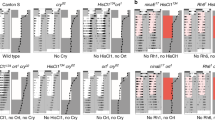Summary
-
1.
Paint over the entire head (except mouth appendages) causes cockroaches to “free-run” in 24 hour light/dark cycles (LD 12∶12): the paint, therefore, blocks the normal pathway of light signals which otherwise would entrain the rhythm.
-
2.
Surgical removal of both ocelli does not interfere with the action of light cycles in entraining the rhythm: ocelli are not a necessary pathway for light signals.
-
3.
Bilateral section of the optic nerves (between the optic lobe and the base of the ommatidia) causes the animals to “free-run” in LD 12∶12, even though the ocelli and ocellar nerves were left intact. The compound eyes are therefore the pathway for entraining light signals. Ocelli are not only not necessary, they are not sufficient.
-
4.
In animals in which painting the entire head cause loss of entrainment removal of the paint from the antennal socket — or insertion of a glass window over the protocerebrum — can cause entrainment to be re-established. However, light entering via the socket or window is probably not absorbed directly by the brain. Windows in animals in which both optic nerves have been severed fail to re-establish entrainment: light leaking into the head capsule by antennal socket or window is evidently effective only when it activates ommatidial elements.
Zusammenfassung
-
1.
Küchenschaben zeigen im 24 Std-Licht-Dunkel-Wechsel (LD 12∶12) eine freilaufende Aktivitätsrhythmik, wenn der gesamte Kopf (mit Ausnahme der Mundanhänge) mit Farbe bedeckt ist: Die Farbe blockiert also den Weg der Lichtsignale, die normalerweise „entrainment“ der Rhythmik bewirken.
-
2.
Operative Entfernung der beiden Ocelli stört nicht die „entrainment“-Wirkung des Lichtes: Die Ocelli sind also nicht als Weg für Lichtsignale nötig.
-
3.
Bilaterale Durchtrennung der optischen Nerven (zwischen optischem Lappen und Basis der Ommatidien) führt zu freilaufender Rhythmik in LD 12∶12, obwohl die Ocelli und die Nerven der Ocelli intakt geblieben waren. Der Weg der steuernden Lichtsignale führt also über die zusammengesetzten Augen. Ocelli sind nicht nur nicht nötig, sondern allein auch nicht ausreichend.
-
4.
Tiere, die durch Bemalen des Kopfes ihr „entrainment“ verloren hatten, können es wiedergewinnen, wenn die Farbe von der Antennenbasis entfernt wird oder ein Glasfenster über das Protocerebrum geklebt wird. Wahrscheinlich wird das via Antennenbasis oder Fenster einfallende Licht jedoch nicht direkt vom Gehirn absorbiert. Tiere mit Fenster, denen beide optische Nerven durchtrennt waren, zeigen nämlich kein „entrainment“: offenbar ist Licht, das durch die Antennenbasis oder durch das Fenster fällt, nur wirksam, wenn es Ommatidien-Elemente aktiviert.
Similar content being viewed by others
References
Bünning, E.: Die endogene Tagesrhythmik als Grundlage der photoperiodischen Reaktion. Ber. dtsch. bot. Ges. 54, 590–607 (1936).
Cloudsley-Thompson, J. L.: Studies in diurnal rhythms. III. Photoperiodism in the cockroach Periplaneta americana (L). Ann. Mag. Nat. Hist. 6 (No. 69), 705–712 (1953).
Harker, J. E.: Factors controlling the diurnal rhythm of activity in Periplaneta americana. J. exp. Biol. 33, 224–234 (1956).
Lees, A. D.: The location of the photoperiodic receptors in the aphid Megoura viciae Buckton. J. exp. Biol. 41, 119–133 (1964).
Nishitsutstuji-Uwo, J., S. F. Petropulos, and C. S. Pittendrigh: Central nervous system control of circadian rhythmicity in the cockroach. I. The role of the pars intercerebralis. Biol. Bull. Wood's Hole (in press) (1967a).
—, and C. S. Pittendrigh: Central nervous system control of circadian rhythmicity in the cockroach. III. The optic lobes; locus of the driving oscillation ? Z. vergl. Physiol. 58, 14–46 (1967b).
Pittendrigh, C. S.: Circadian systems. I. The driving oscillation and its assay in Drosophila pseudoobscura. Proc. nat. Acad. Sci. (Wash.) (in press) (1967).
Roberts, S. K. de F.: Photoreception and entrainment of cockroach activity rhythms. Science 148, 958–959 (1965).
Author information
Authors and Affiliations
Additional information
This work was supported by the National Aeronautics and Space Administration under Contract No. 223 and U.S. Air Force Contract No. AF-F4 4620-67-C-0025. We are grateful to Mr. Roman Charydczak for his able assistance in the construction and maintenance of our recording equipment.
Rights and permissions
About this article
Cite this article
Nishiitsutsuji-Uwo, J., Pittendrigh, C.S. Central nervous system control of circadian rhythmicity in the cockroach. Z. Vergl. Physiol. 58, 1–13 (1968). https://doi.org/10.1007/BF00302433
Received:
Issue Date:
DOI: https://doi.org/10.1007/BF00302433




